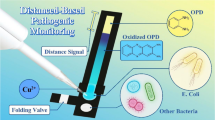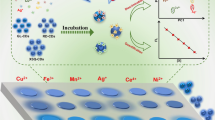Abstract
Caffeine naturally occurs in tea and cocoa, which is also used as an additive in beverages and has pharmacological effects such as refreshing, antidepressant, and digestion promotion, but excessive caffeine can cause harm to the human body. In this work, based on the specific response between nano zinc 5, 10, 15, 20-tetra(4-pyridyl)-21H-23H-porphine (nano ZnTPyP)-CdTe quantum dots (QDs) and caffeine, combined with chemometrics, a visual paper-based sensor was constructed for rapid and on-site detection of caffeine. The fluorescence of QDs can be quenched by nano ZnTPyP. When caffeine is added to the system, it can pull nano ZnTPyP off the surface of the QDs to achieve fluorescence recovery through electrostatic attraction and nitrogen/zinc coordination. The detection range is 5 × 10−11~3 × 10−9 mol L−1, and the detection limit is 1.53 × 10−11 mol L−1 (R2 = 0.9990) (S/N = 3). The paper-based sensor constructed exhibits good results in real samples, such as tea water, cell culture fluid, newborn bovine serum, and human plasma. Therefore, the sensor is expected to be applied to the rapid instrument-free detection of caffeine in food and biological samples.
Graphical abstract





Similar content being viewed by others
References
Furtado LD, Goncalves MC, Inocencio CV, Pinto EM, Martins DD, Semaan FS (2019) Electrodeposition of 4-benzenesulfonic acid onto a graphite-epoxy composite electrode for the enhanced voltammetric determination of caffeine in beverages. J Anal Methods Chem 2019:8596484–8596411. https://doi.org/10.1155/2019/8596484
Kalaiyarasi J, Meenakshi S, Gopinath SC, Pandian K (2017) Mediator-free simultaneous determination of acetaminophen and caffeine using a glassy carbon electrode modified with a nanotubular clay. Microchim Acta 184(11):4485–4494. https://doi.org/10.1007/s00604-017-2483-x
Shishov A, Volodina N, Nechaeva D, Gagarinova S, Bulatov A (2019) An automated homogeneous liquid-liquid microextraction based on deep eutectic solvent for the HPLC-UV determination of caffeine in beverages. Microchem J 144:469–473. https://doi.org/10.1016/j.microc.2018.10.014
Jones J, Magri R, Rios R, Jones M, Plate C, Lewis D (2011) The detection of caffeine and cotinine in umbilical cord tissue using liquid chromatography–tandem mass spectrometry. Anal Methods 3(6):1310–1315. https://doi.org/10.1039/c0ay00625d
Waring WS, Laing WJ, Good AM, Malkowska AM (2009) Acute caffeine ingestion: clinical features in patients attending the emergency department and Scottish poison centre enquiries between 2000 and 2008. Scott Med J 54:3–6. https://doi.org/10.1258/rsmsmj.54.4.3
Fernando CD, Soysa P (2016) Simple isocratic method for simultaneous determination of caffeine and catechins in tea products by HPLC. SpringerPlus 5:970. https://doi.org/10.1186/s40064-016-2672-9
Zhang WF, Zhang YF, Zhou LL, Zhao SN, Du HF, Ma X, Zhang SS (2016) Sensitive analysis of trace caffeine in human serum by HPLC using tetraazacalix[2]arene[2]triazine-modified silica as SPE sorbent. Anal Methods 8(17):3613–3619. https://doi.org/10.1039/c6ay00594b
Huang M, Gao JY, Zhai ZG, Liang QL, Wang YM, Bai YQ (2012) An HPLC-ESI-MS method for simultaneous determination of fourteen metabolites of promethazine and caffeine and its application to pharmacokinetic study of the combination therapy against motion sickness. J Pharm Biomed Anal 62:119–127. https://doi.org/10.1016/j.jpba.2011.12.033
Sun PZ, Lee WN, Zhang RC, Huang CH (2016) Degradation of DEET and caffeine under UV/chlorine and simulated sunlight/chlorine conditions. Environ Sci Technol 50:13265–13273. https://doi.org/10.1021/acs.est.6b02287
Grandke J, Oberleitner L, Resch-Genger U, Garbe LA (2013) Quality assurance in immunoassay performance—comparison of different enzyme immunoassays for the determination of caffeine in consumer products. Anal Bioanal Chem 405:1601–1611. https://doi.org/10.1007/s00216-012-6596-0
Carvalho JJ, Weller MG, Panne U, Schneider RJ (2010) A highly sensitive caffeine immunoassay based on a monoclonal antibody. Anal Bioanal Chem 396:2617–2628. https://doi.org/10.1007/s00216-010-3506-1
Belay A, Kim HK, Hwang YH (2016) Binding of caffeine with caffeic acid and chlorogenic acid using fluorescence quenching, UV/vis and FTIR spectroscopic techniques. Luminescence 31:565–572. https://doi.org/10.1002/bio.2996
Klostranec JM, Chan WCW (2010) Quantum dots in biological and biomedical research: recent progress and present challenges. Adv Mater 18:1953–1964. https://doi.org/10.1002/adma.200500786
Yin H, Truskewycz A, Cole IS (2020) Quantum dot (QD)-based probes for multiplexed determination of heavy metal ions. Microchim Acta 187:336. https://doi.org/10.1007/s00604-020-04297-5
Wu P, Zhao T, Wang SL, Hou XD (2013) Semicondutor quantum dots-based metal ion probes. Nanoscale 6:43–64. https://doi.org/10.1039/c3nr04628a
Zhu Z, Li H, Xiang Y, Koh K, Hu X, Chen H (2020) Pyridinium porphyrins and AuNPs mediated bionetworks as SPR signal amplification tags for the ultrasensitive assay of brain natriuretic peptide. Microchim Acta 187(6):327–336. https://doi.org/10.1007/s00604-020-04289-5
Franck B, Nonn A (1995) Novel porphyrinoids for chemistry and medicine by biomimetic syntheses. Angew Chem Int Edit 34:1795–1811. https://doi.org/10.1002/anie.199517951
Ehli C, Rahman GMA, Jux N, Balbinot D, Guldi DM, Paolucci F, Marcaccio M, Paolucci D, Melle-Franco M, Zerbetto F, Campidelli S, Prato M (2006) Interactions in single wall carbon nanotubes/pyrene/porphyrin nanohybrids. J Am Chem Soc 128:11222–11231. https://doi.org/10.1021/ja0624974
O’Sullivan MC, Sprafke JK, Kondratuk DV, Rinfray C, Claridge TDW, Saywell A, Blunt MO, O'Shea JN, Beton PH, Malfois M (2011) Vernier templating and synthesis of a 12-porphyrin nano-ring. Nature 469:72–75. https://doi.org/10.1038/nature09683
Tashiro K, Murafuji T, Sumimoto M, Fujitsuka M, Yamazaki S (2020) The formation mechanism of ZnTPyP fibers fabricated by a surfactant-assisted method. New J Chem 44(32):13824–13833. https://doi.org/10.1039/d0nj02829k
Kazuya O, Yoshiaki K (2010) Formation of a giant supramolecular porphyrin array by self-coordination. Angew Chem Int Edit 39(22):4070–4073. https://doi.org/10.1002/1521-3773(20001117)39:22<4070::AID-ANIE4070>3.0.CO;2-C
Ahmed GH, Aly SM, Usman A, Eita M, Melnikov VA, Mohammed O (2015) Quantum confinement-tunable intersystem crossing and the triplet state lifetime of cationic porphyrin-CdTe quantum dot nano-assemblies. Chem Commun 51(38):8010–8013. https://doi.org/10.1039/c5cc01542a
Zhao CQ, Rehman FU, Jiang H, Jiang H, Selke M, Wang X, Liu CY (2016) Titanium dioxide-tetra sulphonatophenyl porphyrin nanocomposites for target cellular bio-imaging and treatment of rheumatoid arthritis. Sci China Chem 59(5):637–642. https://doi.org/10.1007/s11426.016-5568-1
Li M, Zheng Y, Liang W, Yuan Y, Chai Y, Yuan R (2016) An ultrasensitive “on-off-on” photoelectrochemical aptasensor based on signal amplification of fullerene@CdTe quantum dots sensitized structure and efficient quenching with manganese porphyrin. Chem Commun 52:8138–8141. https://doi.org/10.1039/c6cc02791a
Wang Q, Yin QB, Fan Y, Zhang L, Hu O, Guo XM, Shi Q, Fu HY, She YB (2019) Double quantum dots-nanoporphyrin fluorescence-visualized paper-based sensors for detecting organophosphorus pesticides. Talanta 199:46–53. https://doi.org/10.1016/j.talanta.2019.02.023
Fu HY, Hu O, Fan Y, Hu Y, Huang JH, Wang Z, She YB (2019) Rational design of an “on-off-on” fluorescent assay for chiral amino acids based on quantum dots and nanoporphyrin. Sensors Actuators B Chem 287:1–8. https://doi.org/10.1016/j.snb.2019.02.023
Chen H, Wang S, Fu H, Xie H, Lan W, Xu L, Zhang L, She Y Dual-QDs ratios fluorescent probe for sensitive and selective detection of silver ions contamination in real sample. Spectrochim Acta A 234:118248. https://doi.org/10.1016/j.saa.2020.118248
Chen H, Wei L, Guo X, Hai C, Xu L, Zhang L, Lan W, Zhou C, She Y, Fu H (2020, 2020) Determination of l-theanine in tea water using fluorescence-visualized paper-based sensors based on CdTe quantum dots/corn carbon dots and nano-porphyrin with chemometrics. J Sci Food Agric. https://doi.org/10.1002/jsfa.10882
Chen XP, Tang MQ, Liu Y, Huang JQ, Liu ZY, Tian HY, Zheng YT, de la Chapelle ML, Zhang Y, Fu WL (2019) Surface-enhanced Raman scattering method for the identification of methicillin-resistant Staphylococcus aureus using positively charged silver nanoparticles. Microchim Acta 186(2):102–110. https://doi.org/10.1007/s00604-018-3150-6
Botelho BG, Reis N, Oliveira LS, Sena MM (2015) Development and analytical validation of a screening method for simultaneous detection of five adulterants in raw milk using mid-infrared spectroscopy and PLS-DA. Food Chem 181:31–37. https://doi.org/10.1016/j.foodchem.2015.02.077
Mevik BH, Cederkvist HR Mean squared error of prediction (MSEP) estimates for principal component regression (PCR) and partial least squares regression (PLSR). J Chemom 18:422–429. https://doi.org/10.1002/cem.887
Du CX, Ma CQ, Gu J, Li L, Chen GQ (2020) Fluorescence sensing of caffeine in tea beverages with 3,5-diaminobenzoic acid. Sensors 20:819. https://doi.org/10.3390/s20030819
Nemati F, Hosseini M, Zaredorabei R, Salehnia F, Ganjali MR (2018) Fluorescent turn on sensing of caffeine in food sample based on sulfur-doped carbon quantum dots and optimization of process parameters through response surface methodology. Sensors Actuators B Chem 273:25–34. https://doi.org/10.1016/j.snb.2018.05.163
Zhang Y, Shang J, Jiang B, Zhou XR, Wang JH (2017) Electrochemical determination of caffeine in oolong tea based on polyelectrolyte functionalized multi-walled carbon nanotube. Int J Electrochem Sc 12:2552–2562. https://doi.org/10.20964/2017.03.02
Deng HY, Wang B, Wu M, Deng B, Xie LW, Guo YP (2019) Rapidly colorimetric detection of caffeine in beverages by silver nanoparticle sensors coupled with magnetic molecularly imprinted polymeric microspheres. Int J Food Sci Technol 54:202–211. https://doi.org/10.1111/ijfs.13924
Sivrikaya S (2020) A deep eutectic solvent based liquid phase microextraction for the determination of caffeine in Turkish coffee samples by HPLC-UV. Food Addit Contam A 37:488–495. https://doi.org/10.1080/19440049.2020.1711972
Bahari D, Babamiri B, Salimi A, Salimizand H (2020) Ratiometric fluorescence resonance energy transfer aptasensor for highly sensitive and selective detection of Acinetobacter baumannii bacteria in urine sample using carbon dots as optical nanoprobes. Talanta 221:121619. https://doi.org/10.1016/j.talanta.2020.121619
Liu L, Huang Q, Tanveer ZI, Jiang K, Zhang JH, Pan H, Luan LJ, Liu XS, Han Z, Wu YJ (2020) “Turn off-on” fluorescent sensor based on quantum dots and self-assembled porphyrin for rapid detection of ochratoxin A. Sensor Actuat B-Chem 302:127212.1–127212.8. https://doi.org/10.1016/j.snb.2019.127212
Funding
This study received financial support from the National Key R&D Program of China (no. 2020YFC1712700), the National Natural Science Foundation of China (grants nos. 31972164, 21776321, 32001789, 21665022, 21776259), Guizhou Provincial Science and Technology Department (nos. QKHJC [2017]1186, QKHZC [2019]2816, and QKHPTRC [2020]5009), the Talented Researcher Program from Guizhou Provincial Department of Education (QJHKYZ [2018]073), Tongren Science and Technology Bureau (No.TSKY2019-3), and the Talented Youth Cultivation Program from “the Fundamental Research Funds for the Central Universities”, and South-Central University for Nationalities (No. CZP20007).
Author information
Authors and Affiliations
Corresponding author
Ethics declarations
Conflict of interest
The authors declare that they have no competing interests.
Additional information
Publisher’s note
Springer Nature remains neutral with regard to jurisdictional claims in published maps and institutional affiliations.
Highlights
1. A paper-based sensor for visual detection of caffeine was constructed.
2. This sensor was built based on nano ZnTPyP and CdTe QDs.
3. This method has an ultra-low detection limit for caffeine (3.153 × 10−10 mol L−1).
4. Nano ZnTPyP bind to caffeine through electrostatic attraction and coordination.
Supplementary information
ESM 1
(DOCX 2020 kb).
Rights and permissions
About this article
Cite this article
Chen, H., Liu, R., Guo, X. et al. Visual paper-based sensor for the highly sensitive detection of caffeine in food and biological matrix based on CdTe-nano ZnTPyP combined with chemometrics. Microchim Acta 188, 27 (2021). https://doi.org/10.1007/s00604-020-04663-3
Received:
Accepted:
Published:
DOI: https://doi.org/10.1007/s00604-020-04663-3




